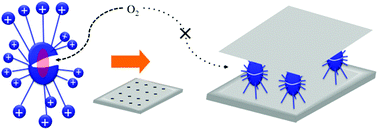Room temperature phosphorescence from a guest molecule confined in the restrictive space of an organic–inorganic supramolecular assembly†
Abstract
Stable room-temperature phosphorescence of guest aromatic molecules was achieved by the effective suppression of oxygen quenching. The organic capsule (first wall) suppressed static oxygen quenching by enclosing a guest molecule, and dynamic quenching via the capsule opening–closing process was well suppressed and manipulated by the intercalation of this capsule into the restrictive space between clay nanosheets (second wall).



 Please wait while we load your content...
Please wait while we load your content...